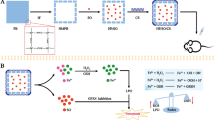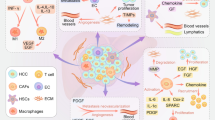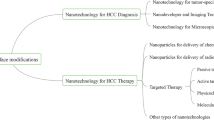Abstract
To eliminate the toxic effect of chemotherapy drug of lobaplatin (LBP) on body tissue in liver cancer therapy, this work prepared a nanodrug carrier based on polyethylene glycol-modified carbon nanotubes (PEG–CNTs) and then constructed a targeted drug delivery system (LBP–PEG–CNTs) by loading LBP on PEG–CNTs. Fluorescein isothiocyanate (FITC) was used to label PEG–CNTs to observe the cellular uptake of PEG–CNTs. In addition, the inhibitions of LBP–PEG–CNTs on HepG2 cells were investigated. The results show that the FITC-labeled PEG–CNTs have good cell penetrability; meanwhile, LBP–PEG–CNTs have good stability, pH-controlled release property, and high inhibition rate on HepG2 cells. To be specific, 80% of LBP is released under physiological conditions of liver cancer cells at pH 5.0, and LBP–PEG–CNTs show a high inhibition rate of 77.86% on HepG2 cells, demonstrating that they have targeted, pH-controlled release and inhibition properties on HepG2 cells.








Similar content being viewed by others
References
A.B. Ryerson, C.R. Eheman, S.F. Altekruse, J.W. Ward, A. Jemal, R.L. Sherman, and R.N. Anderson: Annual report to the nation on the status of cancer, 1975–2012, featuring the increasing incidence of liver cancer. Cancer 122, 1312 (2016).
L.R. Ke, W.X. Xia, W.Z. Qiu, X.J. Huang, J. Yang, Y.H. Yu, and X. Guo: Safety and efficacy of lobaplatin combined with 5-fluorouracil as first-line induction chemotherapy followed by lobaplatin-radiotherapy in locally advanced nasopharyngeal carcinoma: Preliminary results of a prospective phase II trial. BMC Canc. 17, 134 (2017).
S. Mukherjee, I. Mitra, S. Mahata, W. Linert, and S.C. Moi: Hydrolysis mechanism of anticancer drug lobaplatin in aqueous medium under neutral and acidic conditions: A DFT study. Chem. Phys. Lett. 663, 115 (2016).
X.E. Huang, G.L. Wei, J.G. Huo, X.N. Wang, Y.Y. Lu, X.Y. Wu, and J.F. Feng: Intrapleural or intraperitoneal lobaplatin for treatment of patients with malignant pleural effusion or ascites. Asian Pac. J. Cancer Prev. APJCP 14, 2611 (2013).
M. Kanamala, W.R. Wilson, M. Yang, B.D. Palmer, and Z. Wu: Mechanisms and biomaterials in pH-responsive tumour targeted drug delivery: A review. Biomaterials 85, 152 (2016).
S. Vardharajula, S.Z. Ali, P.M. Tiwari, E. Eroğlu, K. Vig, V.A. Dennis, and S.R. Singh: Functionalized carbon nanotubes: Biomedical applications. Int. J. Nanomed. 7, 536 (2012).
S. Kruss, A.J. Hilmer, J. Zhang, N.F. Reuel, B. Mu, and M.S. Strano: Carbon nanotubes as optical biomedical sensors. Adv. Drug Delivery Rev. 65, 1933 (2013).
B. Dineshkumar, K. Krishnakumar, A.R. Bhatt, D. Paul, J. Cherian, A. John, and S. Suresh: Single-walled and multi-walled carbon nanotubes based drug delivery system: Cancer therapy: A review. Indian J. Canc. 52, 262 (2015).
A. Al Faraj, A.P. Shaik, and A.S. Shaik: Magnetic single-walled carbon nanotubes as efficient drug delivery nanocarriers in breast cancer murine model: Noninvasive monitoring using diffusion-weighted magnetic resonance imaging as sensitive imaging biomarker. Int. J. Nanomed. 10, 157 (2015).
J.J. Liu, C. Wang, X.J. Wang, X. Wang, L. Cheng, Y.G. Li, and Z. Liu: Mesoporous silica coated single-walled carbon nanotubes as a multifunctional light-responsive platform for cancer combination therapy. Adv. Funct. Mater. 25, 384 (2015).
W.L. Zhang, J.L. He, Z. Liu, P.H. Ni, and X.L. Zhu: Biocompatible and pH-responsive triblock copolymer mPEG-b-PCL-b-PDMAEMA: Synthesis, self-assembly, and application. J. Polym. Sci., Part A: Polym. Chem. 48, 1079 (2010).
M. Das, D. Bandyopadhyay, R.P. Singh, H. Harde, S. Kumar, and S. Jain: Orthogonal bio-functionalization of magnetic nano-particles via “clickable” poly(ethylene glycol) silanes: A “universal ligand” strategy to design stealth and target-specific nano-carriers. J. Mater. Chem. 22, 24652 (2012).
S.M. Moghimi, A.C. Hunter, and J.C. Murray: Long-circulating and target-specific nanoparticles: Theory to practice. Pharmacol. Rev. 53, 283 (2001).
S. Prakash, M. Malhotra, W. Shao, C. Tomaro-Duchesneau, and S. Abbasi: Polymeric nanohybrids and functionalized carbon nanotubes as drug delivery carriers for cancer therapy. Adv. Drug Delivery Rev. 63, 1340 (2011).
P.C. Lee, Y.C. Chiou, and J.M. Wong: Targeting colorectal cancer cells with single-walled carbon nanotubes conjugated to anticancer agent SN-38 and EGFR antibody. Biomaterials 34, 8756 (2013).
S.P. Yu, W. Yuan, Y.D. Gao, L.Q. Wei, and B.S. Xu: The distribution of intravenously administered functionalized carbon nanotubes in rabbit tissue and their urinary excretion. N. Carbon Mater. 27, 421 (2012).
M.E. Davis, Z.G. Chen, and D.M. Shin: Nanoparticle therapeutics: An emerging treatment modality for cancer. Nat. Rev. Drug Discov. 7, 771 (2008).
R.P. Feazell, N. Nakayama-Ratchford, and H. Dai: Soluble single-walled carbon nanotubes as longboat delivery systems for platinum(IV) anticancer drug design. J. Am. Chem. Soc. 129, 8438 (2007).
L.Z. Gao, L. Nie, T.H. Wang, Y.J. Qin, Z.X. Guo, D.L. Yang, and X.Y. Yan: Carbon nanotube delivery of the GFP gene into mammalian cells. ChemBioChem 7, 239 (2006).
H. Dumortier, S. Lacotte, and G. Pastorin: Functionalized carbonnanotube arc non-cytotoxic and preserve the functionality of primary immune cells. Nano Lett. 6, 1522 (2006).
C. Tripisciano, M.H. Rümmeli, and X. Chen: Multi-wall carbon nanotubes—A vehicle for targeted Irinotecan drug delivery. Phys. Status Solidi B 247, 2673 (2010).
A.A. Bhirde, V. Patel, J. Gavard, G. Zhang, A.A. Sousa, A. Masedunskas, and J.F. Rusling: Targeted killing of cancer cells in vivo and in vitro with EGF-directed carbon nanotube-based drug delivery. ACS Nano 3, 307 (2009).
L.L. Wu, C.J. Man, H. Wang, X.H. Lu, Q.H. Ma, Y. Cai, and W.S. Ma: PEGylated multi-walled carbon nanotubes for encapsulation and sustained release of oxaliplatin. Pharmaceut. Res. 30, 412 (2013).
ACKNOWLEDGMENTS
This study was financially supported by Shanxi Provincial Key Research and Development Program (201703D321015-1) and the Shanxi Provincial Key Innovative Research Team in Science and Technology (2015013002-10 and 201605D131045-10).
Author information
Authors and Affiliations
Corresponding authors
Supplementary Material
Rights and permissions
About this article
Cite this article
Yu, S., Li, Q., Wang, J. et al. A targeted drug delivery system based on carbon nanotubes loaded with lobaplatin toward liver cancer cells. Journal of Materials Research 33, 2565–2575 (2018). https://doi.org/10.1557/jmr.2018.197
Received:
Accepted:
Published:
Issue Date:
DOI: https://doi.org/10.1557/jmr.2018.197




